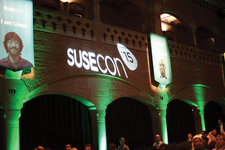Conference coverage
SUSECon 2015

We provide some highlights from SUSECon 2015.
This year's SUSECon was held November 2-6 in Amsterdam, the capital of the Netherlands. This was the first SUSECon I've attended, and I was impressed with the magnitude of the event. The venue was Beurs van Berlage [1], which was designed as a commodity exchange by architect Hendrik Petrus Berlage and constructed between 1896 and 1903. SUSE's creative teams did a magnificent job of SUSE-fying the inside of the building.
The Event
My perception is that the conference had three focus areas: 1) ISVs and partners; 2) developers and DevOps; and 3) new talent. SUSE brought many of their big and small partners under the same roof: IBM, Intel, HP, SAP, Fujitsu, etc. IBM came with their LinuxONE mainframe, which was a center of attraction, with many people trying to get their picture taken with this monstrous machine.
The conference also featured hundreds of hands-on workshops and talks, which ranged from topics like OpenStack and Docker to the very basics of Linux. The target audience for these sessions was developers and DevOps teams. Full days were dedicated to certification exams and other training. The conference was a complete package: You had vendors who bring business, developers and admins who handle the infrastructure of these businesses, and fresh blood.
[...]
Buy this article as PDF
(incl. VAT)
Buy Linux Magazine
Subscribe to our Linux Newsletters
Find Linux and Open Source Jobs
Subscribe to our ADMIN Newsletters
Support Our Work
Linux Magazine content is made possible with support from readers like you. Please consider contributing when you’ve found an article to be beneficial.

News
-
Parrot OS Switches to KDE Plasma Desktop
Yet another distro is making the move to the KDE Plasma desktop.
-
TUXEDO Announces Gemini 17
TUXEDO Computers has released the fourth generation of its Gemini laptop with plenty of updates.
-
Two New Distros Adopt Enlightenment
MX Moksha and AV Linux 25 join ranks with Bodhi Linux and embrace the Enlightenment desktop.
-
Solus Linux 4.8 Removes Python 2
Solus Linux 4.8 has been released with the latest Linux kernel, updated desktops, and a key removal.
-
Zorin OS 18 Hits over a Million Downloads
If you doubt Linux isn't gaining popularity, you only have to look at Zorin OS's download numbers.
-
TUXEDO Computers Scraps Snapdragon X1E-Based Laptop
Due to issues with a Snapdragon CPU, TUXEDO Computers has cancelled its plans to release a laptop based on this elite hardware.
-
Debian Unleashes Debian Libre Live
Debian Libre Live keeps your machine free of proprietary software.
-
Valve Announces Pending Release of Steam Machine
Shout it to the heavens: Steam Machine, powered by Linux, is set to arrive in 2026.
-
Happy Birthday, ADMIN Magazine!
ADMIN is celebrating its 15th anniversary with issue #90.
-
Another Linux Malware Discovered
Russian hackers use Hyper-V to hide malware within Linux virtual machines.

